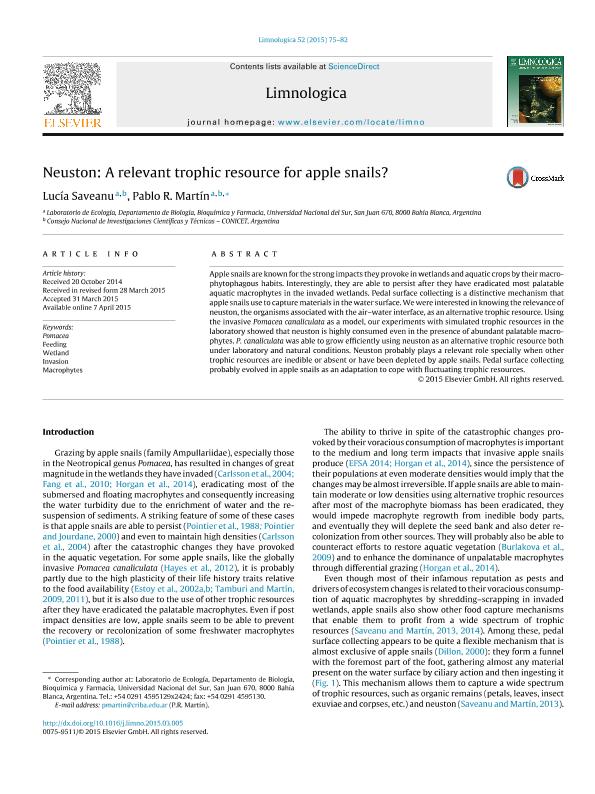Mostrar el registro sencillo del ítem
dc.contributor.author
Saveanu, Lucía

dc.contributor.author
Martín, Pablo Rafael

dc.date.available
2016-07-19T20:35:37Z
dc.date.issued
2015-05
dc.identifier.citation
Saveanu, Lucía; Martín, Pablo Rafael; Neuston: A relevant trophic resource for apple snails?; Elsevier; Limnologica; 52; 5-2015; 75-82
dc.identifier.issn
0075-9511
dc.identifier.uri
http://hdl.handle.net/11336/6618
dc.description.abstract
Apple snails are known for the strong impacts they provoke in wetlands and aquatic crops by their macrophytophagous habits. Interestingly, they are able to persist after they have eradicated most palatable aquatic macrophytes in the invaded wetlands. Pedal surface collecting is a distinctive mechanism that apple snails use to capture materials in the water surface. We were interested in knowing the relevance of neuston, the organisms associated with the air-water interface, as an alternative trophic resource. Using the invasive Pomacea canaliculata as a model, our experiments with simulated trophic resources in the laboratory showed that neuston is highly consumed even in the presence of abundant palatable macrophytes. P. canaliculata was able to grow efficiently using neuston as an alternative trophic resource both under laboratory and natural conditions. Neuston probably plays a relevant role specially when other trophic resources are inedible or absent or have been depleted by apple snails. Pedal surface collecting probably evolved in apple snails as an adaptation to cope with fluctuating trophic resources.
dc.format
application/pdf
dc.language.iso
eng
dc.publisher
Elsevier

dc.rights
info:eu-repo/semantics/openAccess
dc.rights.uri
https://creativecommons.org/licenses/by-nc-nd/2.5/ar/
dc.subject
Pomacea
dc.subject
Feeding
dc.subject
Wetland
dc.subject
Invasion
dc.subject
Macrophytes
dc.subject.classification
Ecología

dc.subject.classification
Ciencias Biológicas

dc.subject.classification
CIENCIAS NATURALES Y EXACTAS

dc.title
Neuston: A relevant trophic resource for apple snails?
dc.type
info:eu-repo/semantics/article
dc.type
info:ar-repo/semantics/artículo
dc.type
info:eu-repo/semantics/publishedVersion
dc.date.updated
2016-07-12T15:22:14Z
dc.journal.volume
52
dc.journal.pagination
75-82
dc.journal.pais
Alemania

dc.journal.ciudad
Berlín
dc.description.fil
Fil: Saveanu, Lucía. Universidad Nacional del Sur. Departamento de Agronomia. Laboratorio de Ecologia; Argentina. Consejo Nacional de Investigaciones Cientificas y Tecnicas. Centro Cientifico Tecnológico Bahia Blanca. Instituto de Ciencias Biologicas y Biomedicas del Sur; Argentina
dc.description.fil
Fil: Martín, Pablo Rafael. Universidad Nacional del Sur. Departamento de Biologia, Bioquimica y Farmacia. Laboratorio de Ecologia; Argentina. Consejo Nacional de Investigaciones Cientificas y Tecnicas. Centro Cientifico Tecnológico Bahia Blanca. Instituto de Ciencias Biologicas y Biomedicas del Sur; Argentina
dc.journal.title
Limnologica

dc.relation.alternativeid
info:eu-repo/semantics/altIdentifier/doi/10.1016/j.limno.2015.03.005
dc.relation.alternativeid
info:eu-repo/semantics/altIdentifier/doi/http://dx.doi.org/10.1016/j.limno.2015.03.005
dc.relation.alternativeid
info:eu-repo/semantics/altIdentifier/url/http://www.sciencedirect.com/science/article/pii/S0075951115000390
Archivos asociados
